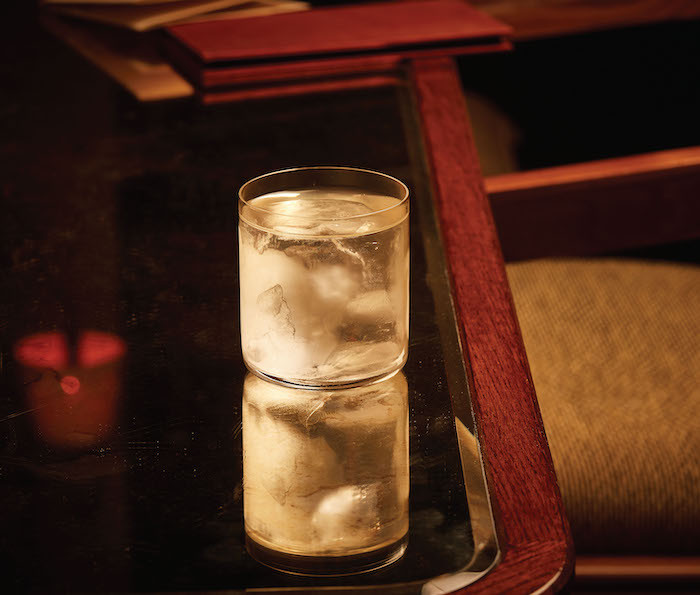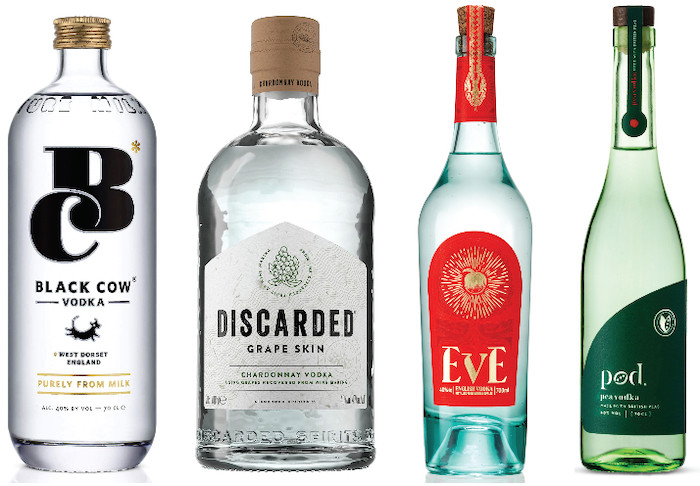
Milk, peas, apples, you name it, vodka is being made from raw materials with assertive flavour profiles. Millie Milliken reports.
It’s a well-trodden trope that vodka should be odourless and flavourless. Indeed, just this week a food and drink podcaster and comedian uttered the sentence: “I think really good vodka doesn’t taste of anything.” It will be news to him then that there are some revolutionaries out there who are working consciously to give bartenders vodka with flavour – and more specifically, the flavour of their raw materials.
Aside from potatoes and grains, the fact that vodka can be made from any other agricultural raw ingredient (as long as it contains enough sugar to convert into alcohol) means that the opportunity for experimentation is endless. From peas to grapes, apples to milk, the world of flavour in vodka is being blown open.
The driving force behind a lot of these brands has been rooted in sustainability: Discarded Grape Skin vodka uses grape skins left over from the winemaking process; while Black Cow vodka utilises the whey left over from the cheddar cheese-making process to turn into its vodka. But while a lot of these vodkas are flavourful and texturally interesting, some newer brands are also making sure to taste of their base ingredient too.
Going green
Flying the greens flag is Pod, a Manchester-based vodka brand made out of peas from Somerleyton Estate in Suffolk, which are fermented and distilled in copper stills in Manchester. It’s the brainchild of Becky Davies (director of Ten Locks Drinks) who wanted to make a spirit with provenance and pea punch – since its launch in February 2023, it has been adopted by the on-trade with fervour.
It took many different iterations to get to the final liquid. “I remember saying that I wanted it to be vegetal, I wanted it to be green and grassy. The first try tasted like cabbage,” says Davies. “We really struggled. We also got a really funky liquid that was just a bit too much.”
The final iteration is a vodka which is sweet, fresh and vegetal with a lift of citrus – and undoubtedly has its basis in peas (a message hammered home by its green bottle and branding). “I need everybody to know that it’s not going to be a neutral vodka,” explains Davies. “It’s all about the raw ingredient. It’s made from peas, and tastes of peas.”
Fruits of labour In Kent, Pleasant Land Distillery has just launched Eve, a vodka which is made out of crushed Braeburn and Gala apples – each bottle containing 16kg of the fruits. Co-founder and distiller Sebastian Barnick is keen to dispel the no-flavour-is-best rhetoric that is so often pedalled about the category.

“That narrative suits enormous brands which have enormous commodity spirit,” he says, also adding that it makes the barrier to entry super-low – “anyone can buy an IBC (international bulk container) and put their own label on it.”
With a background in wine, terroir has played a role in Barnick’s approach to Eve, which also specifies the vintage of the apple crop used. His own German heritage also means that eaux-de-vie (fruit spirits) are part of the brand too. “We’re making a vodka that reflects the heritage of Kent,” says Barnick. “The tonnage of fruit that grows down here is amazing – the varieties, the history, the names.” Eve 2022 vintage is beautifully crisp in texture, with fresh red apple notes and a hint of cereal too.
Rethinking a category
For bartenders, this approach to vodka-making brings with it both opportunities and new challenges when thinking about the category. Simultaneously, it gives them a ready-made base flavour to work with, but also means that some classic vodka cocktails are off limits when it comes to working with these distinct profiles.
“It makes our lives a lot easier,” says Tom Kirk, general manager of Leeds’ Below Stairs of having a vodka with a clear flavour profile to build upon. “There’s a sense of terroir, there’s a direct line between the end product and the raw material.” He also acknowledges, though, that these types of vodkas require a rethink when it comes to the classics: “Trying it in a Cosmo doesn’t work… you can’t just throw it in a Sex on the Beach. You can’t approach it like any other vodka.”
Over at London’s Nipperkin, Angelos Barfas and his team are showcasing British ingredients. He sees Pod as an alternative to agave spirits – a handy switch-in considering the bar’s approach to its spirits selection. This autumn/winter you’ll find it in the Celery & Cucumber alongside Suffolk celery, English cucumbers, Scottish red pepper, and Schofield’s dry vermouth.
“Talking about vodka focused on the flavour is a weird sentence, but it does make sense,” says Bafas. “We live in an era where every bar has its own lab, bartenders are infusing and redistilling – but now we can find vodka with the flavour of its base, and this is a whole new world we can explore.”
The future’s flavour
Back in Leeds and in the Salt section of Below Stairs’ State of Things menu, Dashi combines Pod with Somerset brandy, shiitake dashi, velvet farlernum, sake, gin, coconut and mushroom leaf. “That green savouriness of the shitake lends itself well to Pod,” says Kirk, who tried the likes of pisco and tequila as a base for the drink before realising Pod fitted perfectly.
These vodkas and their complex flavours also lend themselves well to being served neat. At The Rose hotel in Deal, Kent, that’s just how Joseph Benbow is presenting Eve. “We serve it neat and super-cold – it makes a really nice aperitif or after-dinner drink.” He’s also looking at using it in Champagne cocktails: “The fresh apple flavour is particularly versatile, I’m looking forward to really working with it.”
With the likes of Pod and Eve being proof of concept, it will be interesting to see who – and what – follows suit in the category. Barfas for one is here for the change when it comes to refocusing where we find the main flavour in vodka-based cocktails: “Now we can have a vodka drink that actually tastes of the vodka – if that isn’t exciting, I don’t know what is.”


